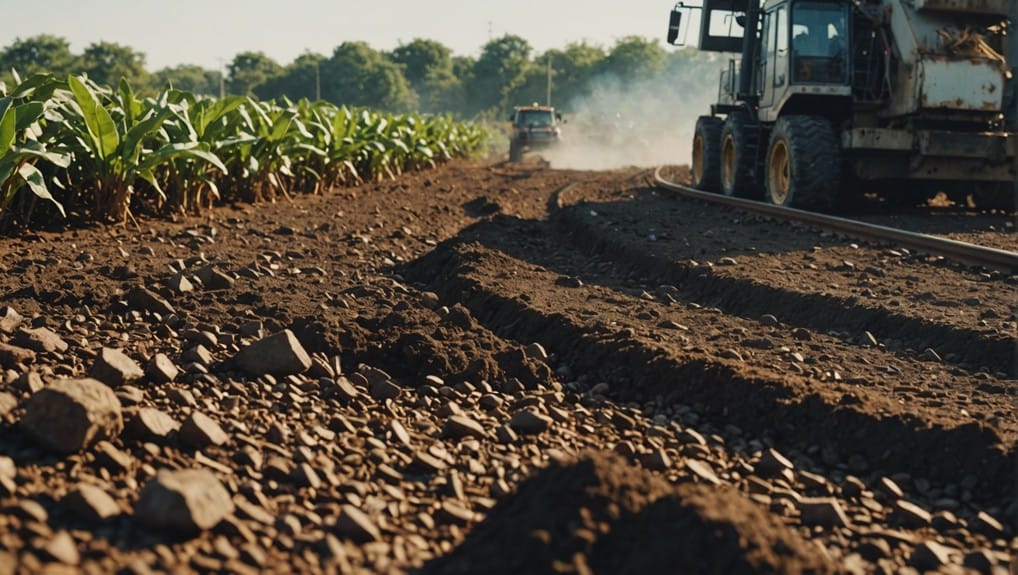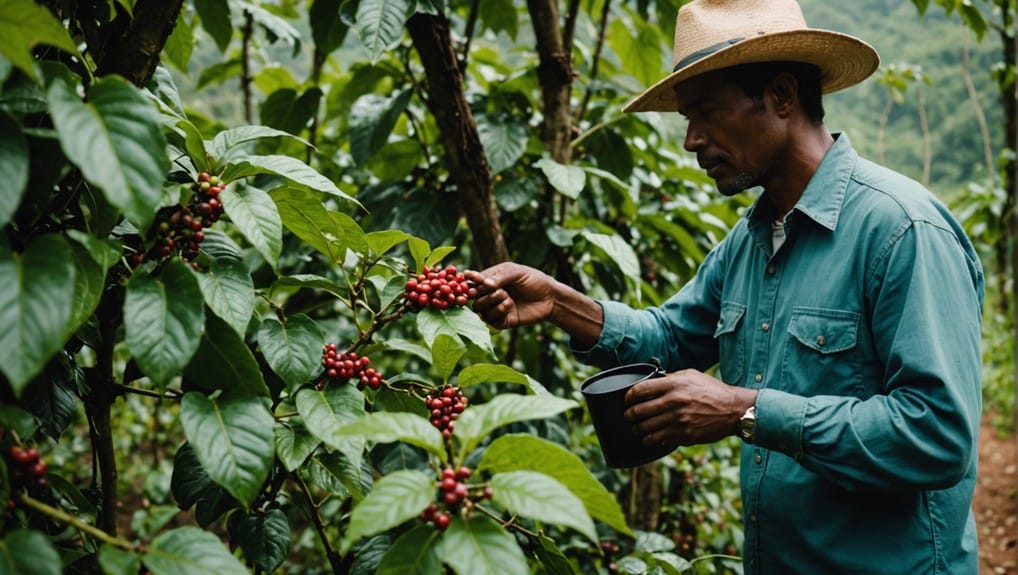Physical Address
304 North Cardinal St.
Dorchester Center, MA 02124
Physical Address
304 North Cardinal St.
Dorchester Center, MA 02124

We’re facing a brewing crisis – literally. Climate change is threatening the world’s coffee supply, and our beloved Arabica beans are on the front lines. Rising temperatures and changing weather patterns are disrupting traditional farming practices and causing yields to decline. Consequently, coffee prices are on the rise. But that’s not everything – deforestation, water waste, and biodiversity loss are likewise major concerns in the coffee industry. Thankfully, farmers are fighting back with sustainable practices, and researchers are developing climate-resilient coffee varieties. The future of coffee is uncertain, but one thing’s clear: we need to take action to save our daily cup.
As we examine the complex relationship between coffee and climate, it’s essential to understand the ideal conditions that promote the growth of this beloved crop.
Coffee primarily grows in the “Bean Belt,” a region between the Tropics of Cancer and Capricorn. Major coffee-producing countries include Brazil, Vietnam, Colombia, and Ethiopia.
To thrive, coffee needs rich soil health and specific conditions, such as elevations between 600 to 2200 meters above sea level.
With over 100 coffee varieties, Arabica and Robusta are the two main species cultivated globally, with Arabica accounting for 60-70% of production because of its superior flavor, whereas Robusta beans have higher caffeine levels Coffea species.
We’ll examine how these conditions impact the growth of our favorite coffee varieties, particularly those requiring ideal temperatures between 60°F and 70°F, and the importance of maintaining healthy soil to support their growth.
Rising global temperatures are casting a dark shadow over the world’s coffee cups. As we sip our morning brew, we’re often unaware of the challenges coffee farmers face because of climate change.
Coffee market fluctuations are becoming more frequent, and it’s not just the farmers who are affected – we, as consumers, will eventually feel the pinch.
With changing weather patterns and rising temperatures, coffee yields are decreasing, leading to higher prices and reduced quality.
It’s time for us to raise our awareness about the impact of climate change on coffee. By understanding the challenges, we can make informed choices and support sustainable practices that help coffee farmers adapt to this new reality.

Coffee production’s dark side is often overlooked in our daily cups. As we savor the rich flavors, we rarely think about the environmental concerns that come with it.
Deforestation impacts and biodiversity loss are just a few of the issues plaguing the coffee industry. Here are some of the key concerns:
These concerns are just the tip of the iceberg, and it’s crucial we acknowledge them to create a more sustainable coffee industry.
We’re facing an uncertain future in the coffee industry, with climate change posing a significant threat to global coffee production.
But farmers are taking action, and it’s a good thing – after all, coffee lovers aren’t ready to give up their morning brews just yet.
One way farmers are adapting is through crop diversification, planting other crops alongside coffee to guarantee they’re not putting all their beans in one basket.
This not only spreads the risk but likewise creates more climate-resilient farms.
By growing a variety of crops, farmers can maintain healthy soil and biodiversity, reducing the need for chemical pesticides and fertilizers.

Through adopting sustainable practices, farmers are working to mitigate the environmental impacts of coffee farming, in addition to ensuring the long-term viability of their farms.
Organic farming, agroforestry benefits, and conservation methods are helping coffee farms stay healthy in a rapidly changing climate.
By making changes now, coffee producers are laying the groundwork for more environmentally-friendly methods and tackling common coffee-growing pitfalls, including erosion, pesticide misuse, and other problematic methods of crop care.
To shift coffee cultivation practices to those of eco-conscious, sustainable practices and to improve environmental outcomes, we encourage farmers to:
As we examine ways to fortify coffee production against the climate crisis, our focus shifts to the development of climate-resilient coffee varieties.
We’re talking about coffee plants that can thrive in warmer temperatures and changing rainfall patterns. To achieve this, researchers are studying climate adaptation strategies, including genetic modification research.
By selectively breeding or genetically modifying coffee plants, scientists hope to create varieties that can resist diseases, pests, and drought. For instance, some coffee cultivars like Castillo are already showing resistance to rising temperatures and drought.
These climate-resilient coffee varieties could be the key to securing the future of coffee production. With ongoing research and development, we’re optimistic about the possibilities.
To achieve widespread coffee sustainability and safeguard against climate-driven risks, the need for international collaboration becomes increasingly critical.
We must work together to protect the future of coffee. This can be achieved through international partnerships, such as the International Coffee Organization, which brings together coffee-producing and consuming countries to address common challenges.
As we aim for sustainability, it’s crucial to reflect on the health benefits of single-origin coffee, which is high in antioxidants and supports environmentally friendly practices.
Moreover, choosing single-origin coffee can promote biodiversity and fair trade practices, eventually contributing to a more sustainable coffee industry.
Here are three ways we can encourage global cooperation for coffee sustainability:
We’ve uncovered the harsh reality: our daily cup of coffee is under threat from the climate crisis. But amidst the challenges, we’ve likewise found glimmers of hope. Innovative farmers, researchers, and companies are joining forces to develop climate-resilient coffee varieties and sustainable practices. It’s time for us to support these efforts and rethink our role in the coffee supply chain. The future of coffee depends on it – and so do the livelihoods of millions.
We’re examining Arabica coffee’s dominance in global production. Even though the exact percentage isn’t specified, Arabica is one of the two main species cultivated, and we support sustainable practices for Arabica and other coffee varieties.
We’re investigating how coffee contributes to global greenhouse gas emissions. Coffee farming is a significant source, with around 10% of global emissions stemming from agriculture, and coffee cultivation being a notable contributor to these greenhouse gases.
We’re researching climate-resilient coffee tree species with desirable traits like shade tolerance and disease resistance, such as Castillo, which exhibits resistance to rising temperatures, drought, and pests, offering hope for sustainable coffee production.
We’re investigating indoor cultivation as a viable option – growing coffee plants in controlled environments with ideal temperatures, humidity, and light can help increase yields and reduce environmental impact, even in non-traditional regions.
We support fair trade, which greatly boosts farmer income by ensuring better prices and market access, ultimately leading to economic stability and improved livelihoods for coffee farmers and their communities worldwide.